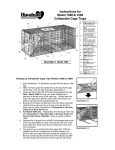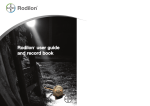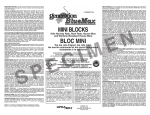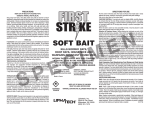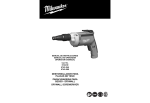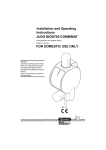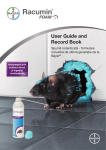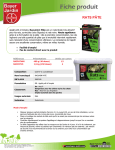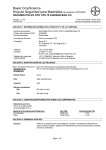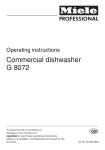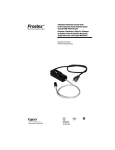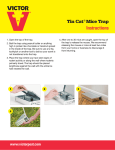Download User Guide and Record Book
Transcript
Entry/Exit holes Loft Spaces Farm Buildings Cavity Walls Cable Trunking Basements New User Guide and Record Book Innovative rodenticide. All new formulation. Contents 1.Introduction 02 2. Why Bayer have produced this guide 03 3. The rodent problem 04 4. Understanding rodent behaviour 06 5. Indications of rodent activity 10 6. Why use Racumin Foam? 11 ® 7. Effective and successful control 12 8. First generation rodenticides 14 and their place as part of an IPM approach 9. How to use Racumin® Foam 16 02 10. Where to use Racumin® Foam 18 11. Good stewardship & the CRRU code 19 12. Foam placement maps 20 13. Foam application programme records 21 14. COSHH Site Assessment form 22 15. Some of your questions answered 24 1. Introduction 2. Why Bayer have produced this guide Racumin® Foam is a new, non-bait rodenticide from Bayer; offering an alternative method to control rat and mouse infestations. This truly innovative foam formulation is Bayer’s latest development in rodent control to be introduced to the UK and Ireland. Rodent control is evolving in Europe. The EU Biocidal Product Directive (98/8/EC) PT14 is triggering important changes in the way rodent control should be managed in all European countries. Unlike baits which are reliant on palatability for uptake, Racumin® Foam works with the rodent’s natural grooming habits and is effective as a result. When faced with situations where traditional baiting methods are not possible (e.g. cavity walls), Racumin® Foam can be used as part of the rodent defence armoury. Racumin® Foam should be used in conjunction with baits as part of an Integrated Pest Management (IPM) approach. There is now increasing pressure to improve best practice and consider alternatives to second generation rodenticides. In line with industry best practice and the legal status of label requirements, all professional pest controllers using rodenticides must plan and record their rodent control programmes. This guide will help you to: Understand the rodent problem Assess whether there is a need for rodenticides Develop an effective Integrated Pest Management (IPM) approach to control rodents Select the correct Bayer formulation for the situation Use rodenticides in accordance with the label to ensure the risk to non-target species is reduced Racumin® Foam is a first generation rodenticide containing the active ingredient coumatetralyl. Image for illustration purposes only, can may vary 03 3. The rodent problem Rats and mice can be a problem in urban, suburban and rural areas. Where ever humans live, rats and mice will thrive given the right conditions to do so. The three most common rodents associated with man are; Norway, common, sewer or brown rat (Rattus norvegicus) Black, ship or roof rat (Rattus rattus) House mouse (Mus musculus) Norway, common, sewer or brown rat Black, ship or roof rat House mouse Rattus rattus Mus musculus By minimising the contact that we have with rodents the risk of disease is reduced. However in our modern world it is often the low standards of hygiene and cleanliness that present the ideal environments for rodents to thrive. To survive and infest a particular building or habitat there are three main requirements rodents need; 1. Food 2. Water (less important for mice) 3. Harbourage It is the combination of these that presents the most attractive habitats. If these requirements are not met then the habitat becomes less attractive and the likelihood that an infestation may occur is reduced. Rattus norvegicus These rodents are known as commensal rodents which literally mean they ‘live off man’s table’. They have adapted their behaviour and feeding habits to enable them to survive in our man made towns, cities and agricultural habitats. Rodents have the ability to carry and transmit diseases that are common to not only themselves and man, but also livestock and domestic pets. 04 The main methods that disease transmission may occur are; Via contaminated urine and faeces Through ectoparasites such as fleas and ticks From physical contact from their fur, feet and bodies A key factor in the management of rodents is the removal of their habitat and food sources. By simply taking these steps the use of rodenticides can be avoided or reduced. The threat from commensal rodents to the health of humans should never be underestimated and where this risk exists use of rodenticides is justified. Best practice and information on how to use baits correctly are widely available but all too often the immediate use of anticoagulant rodenticides is a routine procedure. A change in attitude towards the use of rodenticides is needed to ensure the long term security and availability of such products to responsible and professional users. Careful and considered management of the habitats where an infestation has occurred or is likely to occur could mean that the use of baits is avoided altogether. The understanding of rodent behaviour and biology is a key element in ensuring a high level of control but every site is different and there is no longer a ‘one size fits all’ solution. The choice of rodenticides and their formulations is broad, but it is critical to understand how they should be used and where their use is avoidable. The reduction of risk to non-target animals and the reduction in secondary poisonings is very important. 05 4. Understanding rodent behaviour Before undertaking any rodent control it is critical to understand how rodents behave and live in their environments. Rats Habitat In rural situations rats tend to live outdoors during the warmer parts of the year in fields and hedgerows where there is an abundance of food. As the temperatures begin to fall and food becomes harder to find they migrate towards farms and buildings looking for shelter and food. In towns and cities there is little evidence to suggest that this type of behaviour exists. Activity In general rats are nocturnal and move at night, but in urban situations where infestations are high and food is plentiful rats will openly move between feeding sites and their harbourage. 06 Territory For their own protection the distances that rodents move between nesting sites and feeding sites is kept to a minimum and this is a very important point when assessing a site and putting measures in place to remove or control an infestation. Almost without exception rats move along regular well known routes that remain close to cover and rarely venture into open areas. These ‘rat runs’ are easily identified and play an important part in the effective control of the rats that are using them. Neophobia Perhaps the single most important factor in rat behaviour is their intimate knowledge of the area in which they live. They move by memory and recognition of objects that remain constant and without change. Anything new or strange that is placed in their environment is viewed with extreme caution, equally any disturbance in the habitat will be met with suspicion and prolonged investigation before acceptance takes place. The term for this behaviour is ‘neophobia’ and this can mean that bait, bait boxes or traps are avoided for anything up to place from 2 or 3 feeding points; these are usually familiar and provide safety for the rat. Neophobia is the term used when a rat avoids bait, bait boxes or traps. 10 to 14 days. In extreme circumstances rats may never enter or eat from a baiting point at all. Therefore, some infestations will be very difficult to control and the efficiency of control measures is drastically reduced. All Norway rats display neophobia traits but it is dependent on the particular population and the situation in which they are living that also has a bearing on how developed this reaction can be. Feeding A rat will normally consume about 25g – 30g (10% of their body weight) of food in a 24 hour period. They have a varied and balanced diet and are capable of consuming a wide range of foods. The removal of foodstuffs where there is a rodent problem can play a significant part in controlling the population. Feeding normally takes Rats cannot survive without water and it is an important factor in where they choose to live. A site with free access to water whether it is from leaking taps, drains, water troughs or any other source is critical. The removal of these water sources which are often as a result of poor property maintenance can also contribute to the habitat becoming less attractive to the rat. Colonies An average size colony numbers around 12 individuals and the area in which they live is defended and protected against outside intruders. As populations grow in any habitat dominant individuals of both sexes take better positions close to food sources. Younger or weaker individuals may only be allowed to feed when the dominants have finished and often this can be during daylight hours. Behaviour The site of a nest or harbourage is important for many reasons and as rats are nocturnal they have long periods of rest and sleep – typically up to 35% of a 24 hour period. Despite being perceived as dirty animals rats groom extensively and spend up to 20% of their time cleaning and licking their fur and feet. 07 Mice Habitat The house mouse (Mus musculus) is a very common pest in both urban and agricultural environments and has adapted well to living in close proximity to man. The house mouse mainly lives indoors and will infest a wide range of buildings where conditions are suitable to support a colony. They have a preference for warm, dry conditions and will avoid anywhere that is wet. The range in which a mouse will move is often limited to no more than 10 metres. Once harbourage and a food source have been identified their movement can be as little as 5 square metres. Senses Mice interact with their environment by using the senses of touch, taste, smell, hearing and sight. They are generally nocturnal and most of their activity occurs at night. In some situations where they live in an undisturbed environment activity can be observed throughout a 24 hour period. One of the most important senses is touch. It is used to recognise their 08 surroundings as well as identifying objects. The whiskers are used to detect objects in the dark and to identify known routes or runs. Smell and taste are often used together to identify other individuals as well as information about their surroundings. Colonies are often territorial and smell is used to help recognise intruders, as well as being used to identify and locate food. It is known that they will try food and reject anything that they do not like. It is a common misconception that mice have little or no control of their bladders. Mice urinate to mark territory, identify routes and pass messages within their group. Where a heavy infestation has developed urine pillars can be found. Hearing is a highly acute sense that allows mice to respond to any danger and their response to sudden or loud noise is often instant flight away from an area. Sight is less well developed as their nocturnal behaviour means that good eyesight is not required. Mice are colour blind and only see in black and white. Feeding The mouse can exist and survive on very low quantities of water and often the moisture in its food is sufficient to provide its daily intake. Mice will eat most types of food and this is part of the reason why they have survived so well. They do have a preference for and are attracted to seeds and foods that contain oils. Mice are irregular and erratic feeders and consume between 3 – 4g of food per day. They choose to feed from many different sites and consume small quantities from each one. Behaviour Mice are excellent climbers and will easily climb vertical walls if the surfaces are rough. Any beams, pipes, cables or lintels allow mice to travel freely around buildings. They have an ability to jump and will spend much of their time off ground level and this should be a consideration when placing Racumin® Foam for control. The proofing of a building against mice is very difficult because their small size allows them to pass through gaps as wide as a pencil and once inside a property they quickly find safe harbourage. Unlike rats who exhibit neophobia mice are known to investigate new objects very quickly. They will visit many new sites and objects during periods of activity but their attention span is very limited. When using Racumin® Foam it is important that many application points are placed to ensure uptake is good. Grooming forms part of a mouse’s daily routine and up to 20% of its time is spent grooming and cleaning its fur. The reproductive rates of rats and mice are similar and large infestations can develop quickly from a single pair. A mouse can be sexually mature from 5 – 6 weeks and can produce a litter of between 6 and 10 young. A female house mouse can give birth every 21 days. 09 5. Indications of rodent activity 6. Why use Racumin® Foam? Rodents are nocturnal and feed mainly at night so are rarely seen. The following are signs that rodents are present. Quick and easy to apply; Droppings Rat droppings range between 12mm to 20mm long. Mouse droppings range between 3mm to 6mm long. Urine stains, body smears and odour Rats frequently urinate and leave body smears as they move around. The odour of even small populations of rodents is easily identified. Mice have a different odour to rats. Runways and tracks Well worn paths in vegetation, footprints and tail marks in dust, soft earth and sand indicate a rodent problem. Fluorescent Tracking Dust can aid the detection of a rodent’s movements. Gnawing damage The double gouge marks of rodent twin incisors are easily identified. The relative size of the teeth gouges can give a clue to the species. Burrows Burrows are holes in the ground that lead to a rat’s nest. The burrow entrance is typically 100 mm wide and is commonly found under buildings, patios, compost mounds, wood piles, low vegetation and accumulated heaps of rubbish. More often than not the burrow will be near a water source. 10 Nests Mouse nests are usually found in houses or other such structures to protect them from the weather. Typical locations are loft spaces, garages and under floorboards. The nest will comprise of shredded materials found in and around the building, such as paper, plastic and cloth. Food debris Food debris, such as partially chewed food or empty nut shell cases can be indicators of rodent activity. Rats tend to eat all the food they find, but will still leave inedible food stuffs such as nut shells. Mice often leave half eaten food behind. ready to use product Racumin® Foam offers an ideal solution where bait shyness or neophobia is an issue Racumin® Foam takes advantage of a rat’s grooming behaviour; rats groom 20% of the time in a 24 hour period, therefore contact with Racumin® Foam will ensure ingestion of the active ingredient Can be placed in locations, such as cavity walls, where traditional baiting methods are not possible It provides an additional level of control that cannot be achieved with current baiting techniques Racumin® Foam is not a bait and therefore does not rely on palatability Once applied the disturbed foam provides a good visual guide to the level of rodent activity Racumin® Foam is the perfect complementary control measure which can be used as part of an IPM programme Sightings Rats are nocturnal and are not usually seen during daylight hours. Older, less competitive rats in large populations will look for food during the day as they cannot compete for the food at night. An observation of foraging rats during the day is an indication that a large infestation may be present. Sounds Rats and mice can be heard moving about during quiet periods at night. Gnawing and scratching sounds can also be heard. Racumin® Foam being applied to an entrance hole. Racumin® Foam placed in an inaccessible wall cavity. 11 7. Effective and successful control IPM Approach Racumin® Foam should be used as part of an IPM approach. It should be used in partnership with regular bait treatments. Rodent problem identified? No Yes Norway rats or house mice Continue to monitor Are the rodents living indoors? Combine hygiene management and food source removal where possible to discourage activity Identify an appropriate place to apply the foam inaccessible to non-targets. i.e. a cavity wall or difficult to reach position Follow instructions on can to ensure best results Yes No Racumin® Foam can be used Racumin® Foam is not approved for outdoor use Racumin® Foam is the perfect partner to the range of Rodilon® rodenticides. Rodilon® contains the most recently developed anti-coagulant active ingredient, difethialone and has four of the most palatable bait formulations. Difethialone works like no other anticoagulant because of its molecular configuration and there is currently no known resistance in rats or mice. Are you placing bait already? Yes Continue to monitor and follow best practice guidelines No Racumin® Foam can be used as a complementary measure in conjunction with a rodenticide bait Rodilon® Trio 12 When used as part of an IPM approach in conjunction with Rodilon® or another rodenticide bait, Racumin® Foam can be used to achieve rapid control of rodent infestations. Rodilon® Wheat Tech Rodilon® Blocks Rodilon® Soft Blocks 13 8. First generation rodenticides and their place as part of an IPM approach With pressure to improve best practice and consider alternatives to the potent second generation rodenticides, first generation solutions have an increasingly valuable role to play in a modern IPM approach. Over the years, first generations have developed a reputation of being old, ineffective and suffering from widespread resistance. While this may be the case with warfarin, many people overlook the fact that not all first generations are the same. Formulations containing actives such as coumatetralyl, have fewer resistance strains and are therefore a legitimate consideration for pest controllers. If a pest controller decides that the best form of control of a rodent infestation includes the use of a rodenticide, the geographical location and surrounding environment of the infestation will dictate the options available. 14 Resistance Management It is a known fact that there is resistance to the active ingredients in first and second generation rodenticides in certain areas of the country. That resistance will rule out the use of products containing these actives in these areas, as not only are they likely to be ineffective, but the use of these will act to compound the resistance issue. It is important that resistance is officially identified (e.g. rat tail analysis) before discounting products as the real issue may be palatability of bait and not resistance. There have been known cases in these highly resistant regions where products containing coumatetralyl have managed to control infestations without any trouble because of the formulation type or method of control. If a pest controller is treating in a region where resistance is less of a problem, the use of a first generation is a very effective first choice and it will be of lower risk to non-target wildlife. The Health & Safety Executive (HSE), the Campaign for Responsible Rodenticide Use (CRRU) and the Pest Control industry are working to ensure best practice by developing a stewardship regime for second generation anticoagulant rodenticides (SGARs). Pest Control Operatives (PCOs) need to be aware of all the control options at their disposal and be reminded that there is a place for the use of less potent, but effective, first generations. 15 9. How to use Racumin® Foam Racumin® Foam is intended to be used as a complementary product during the course of a usual baiting programme. 1.For best results use Racumin® Foam at room temperature. 6. Press the button to release the foam. 2. Shake the can vigorously until the mixing ball strikes audibly. 3. Attach the dispensing tube. 7.Apply the foam in known rat runways, passages, entrance points / holes, covered tracks and wall cavities. 8. To enable the rodents to continue using their entrance points do not totally seal the hole with the foam, keep the opening clearly visible. 9.On runs create a foam hurdle that the rodent has to jump over to pass, this will ensure that some foam attaches to the underside of its body. The hurdle must not be too tall, the rodent must be able to see past it; otherwise it will turn around and take a different route. 11.Apply only in places inaccessible to livestock, children, and non-target species. 12. If applying the product overhead ensure that the aerosol can is held upright. 13. Replace the safety cap when you have finished applying Racumin® Foam. 14.The released foam usually lasts for 7-12 days, depending on disturbance and temperature/ humidity. Inaccessible wall cavity. 10. Apply at least 2m from storage locations for food, animal feeding stuffs and food preparation surfaces. 15.Racumin® Foam is ingested by the rat when it grooms itself. 16.For best results use in conjunction with a traditional bait. Application rates For Rats: 4.Remove safety cap and store in a safe place. 5.Do not apply to surfaces likely to stain; perform a patch test if necessary and wipe off excess foam with a dry paper towel. 16 For Mice: Racumin® Foam being applied to an entrance hole. Apply 20g to 30g foam (foam the size of a half brick). (Press the aerosol button for approximately 4 seconds) Apply 4g (foam the size of a tennis ball) to 30g (foam the size of a half brick). (Press the aerosol button for approximately 2 seconds) This quantity can be applied as a single application or as a number of smaller applications along the track. 17 10. Where to use Racumin® Foam 11. Good stewardship and the CRRU (Campaign for Responsible Rodenticide Use) code Indoor use only; in agricultural, Bayer recognises the importance of good stewardship for all its products including Racumin® Foam. As part of our commitment to supporting good stewardship Bayer along with other rodenticide manufacturers and other interested parties came together to form the Campaign for Responsible Rodenticide Use. For practical rodenticide guidance, just follow the CRRU Code. Cavity walls domestic, commercial, food factories, public services, municipal and industrial buildings Rat runways, passages and covered tracks The CRRU Code Entrance points / holes 1. Always have a planned approach Where neophobia issues Wall breakthroughs: waterpipes, 2.Always record quantity of bait used & where it is placed Cable trunking 3. Always use enough baiting points Locations where traditional baiting 4. Always collect and dispose of rodent bodies Suspended ceilings are present methods are not possible Use in conjunction with a bait treatment 5.Never leave bait exposed to non-target animals and birds 6. Never fail to inspect bait regularly 7. Never leave bait down at the end of the treatment For more information on CRRU please visit www.thinkwildlife.org electric cable In rooms with high humidity (where durability of ready to use baits are limited) In locations where there is plentiful alternative food sources meaning take up of baits has been very low When rats refuse baits - bait aversion. 18 19 12. Foam placement maps Use the grid to make a sketch plan of the main building with the infestation. Mark up any potential food sources. Identify where you have seen rats and mice and/or locations where there is damage. Mark the foam application points on the grid. This will help you monitor rodent activity at each point over the period of control. 20 13. Foam application programme records Client name Name and type of rodenticide used Application Date of first point number application Date of foam replacement or top up applications Signature Comments 21 14. COSHH Site Assessment Form 11. Control Measures: This is a Site Assessment form draft and it needs to be customised by the rodenticide user. • 1. Site address________________________________________________________________________ _____________________________________________________________________________________ _____________________________________________________________________________________ • • • 2. Pest species________________________________________________________________________ _____________________________________________________________________________________ _____________________________________________________________________________________ • 3. Briefly describe the task/process_______________________________________________________ _____________________________________________________________________________________ _____________________________________________________________________________________ 4. Who is at risk? Operator Public Environment 5. Substance/product name and description RACUMIN FOAM Ready –To-Use Rodenticide BPR:UK-2014-0860,IE/BPA 70160. Supplied in 500ml can. Blue foam containing Bitrex and 0.4% w/w coumatetralyl, which is a first generation anticoagulant. 6. How is the supplied substance to be used and quantity: To be used as supplied, by placing in appropriate places, as per label instructions. Application rate as per label recommendations, dependant on the rodents being controlled. FOR INDOOR USE by professional users only. 7. Manufacturer Bayer CropScience Ltd, 230 Cambridge Science Park, Milton Road, Cambridge, CB4 0WB Telephone from the UK & the Republic of Ireland: 0080012149451 Email: [email protected] Web: www.pestcontrol-expert.com Emergency number (24h): from the UK; 0800 220876 from the Republic of Ireland: 1800 409399 or nearest National Poisons Information Centre 8. Classification • • • • Avoid all contact by mouth, wash hands and exposed skin before eating, drinking or smoking and after work. Do not lay rodenticide where food, feed or water could become contaminated. Prevent access to the rodenticide by children and animals, particularly dogs and birds. Search for and remove dead rodents at frequent intervals during treatment, at least as often as foam is inspected and/or replaced. Collect dead bodies to prevent public health problems and secondary poisoning and dispose of dead bodies in accordance with local requirements. Remove any product residue when rodents eliminated. Leave client with MSDS. Read the label before use. Update as necessary (site specific). 12. Personal Protective Equipment (PPE) • Wear PPE when handling, as specified on the label/MSDS. 13. First Aid Measures • • • • • General: In case of accident, suspected exposure or if you feel unwell, seek medical advice immediately (show the label/MSDS where possible). Eyes: Remove contact lenses if present and rinse the eye slowly and gently with water for at least 15 mintues. Seek medical advice immediately. Skin: Wash with soap and water. Remove and launder any contaminated clothing. Ingestion: Seek medical attention. Antidote: VITAMIN K1 Seek medical advice in any of the above circumstances 14. Storage & Transport • • • • • • • • This product is extremely flammable. Keep away from heat and sources of ignition. Do not open by force or throw into fire even after use. Do not spray on flames or red-hot objects. Keep away from food, drink and animal feedingstuffs. Keep the container stored in a dry, cool, well-ventilated location. Do not contaminate food, water or feeds by storage or disposal. Transport classification: 1950. 15. Spillage Extremely Flammable • Eye Irritant See MSDS 9. Route of Exposure • • • Ingestion Dermal absorption Wildlife ingestion 10. State the Risks to Health from Identified Hazards • • 22 Health hazards would mostly occur through accidental ingestion, due to the inhibition of the blood coagulation that cause haemorrhagic symptoms. Significant quantities would have to be ingested to provide toxic effects. This has to be taken into account when laying the rodenticide especially with children and non-target animals species being at highest risk. Pest control operator to read and follow all Directions for Use, Precautions and Instructions on the Product label. • • • • Use PPE when handling any spillage Remove all sources of ignition. Do not discharge into soil, drains or surface or ground water. If spillage enters river or watercourses, inform the Environment Agency (emergency telephone number 0800 807060). Collect into suitable containers, which can be labelled and sealed, incinerate or take to a special waste disposal site in accordance with local authority regulations. 16. Disposal of Substances & Contaminated Containers • • • • Disposal of the liquid product when not contained in the aerosol container by incineration in an appropriately licensed commercial incinerator. Advice may be obtained from the local waste regulation authority (part of the Environmental Agency in the UK). Ensure aerosol container is empty before disposal. Waste key for the unused product: 160504. Assessed by: Date: Review Date: 23 15. Some of your questions answered 1.How many applications does 1 can deliver? The volume of foam in 1 can is 12L (500g) This should allow approximately 16-17 applications for rats and up to 125 applications for mice per can. 2.What’s the difference between this product and a contact gel? Foam is lighter and can be applied overhead for use on rats and mice, whereas contact gel is for mice only. As a foam it expands when applied and doesn’t need a gun for application. 3.What is the product’s active ingredient? Racumin® Foam is a first generation anticoagulant containing the active ingredient, coumatetralyl. 4.Is the product for use indoors and outdoors? The product is approved for indoor use only. 5.Is the product Professional Use only? Racumin® Foam is approved for Professional Use only. 24 6.Will the product leave marks or stain? The product can potentially leave blue marks on certain surfaces and should not be used on sensitive surfaces. It is recommended that a test patch is done initially in an inconspicuous area. Excess foam should be cleaned away with dry disposable tissues which can then be disposed of in accordance with local requirements. 7.Are there any areas the product shouldn’t be applied to? Outdoors – it is an indoor use only product Areas where staining may be a concern Junction boxes, bare wires and anywhere you would not apply water Less than 2m from food and animal feed Areas accessible to farm animals, children & pets 8. Is the product flammable? As the product is an aerosol it is highly flammable just like any other aerosol and should be treated in the same way. There should be NO SMOKING when applying and the product must not be sprayed onto a naked flame. 9.Can the product be mixed with baits? No. Racumin® Foam should be used as a complement to your normal rodenticide bait. 13. Is Racumin® Foam waterproof? No 10.How long does it take for the lethal action to occur? As with any other anticoagulant the lethal action occurs 4-6 days after consumption. 15.Will any residues present a contamination issue? Residues are always a contamination issue. Dogs and cats should be kept clear of the area treated and any residues should be cleaned up using dry disposable tissues and then disposed of in accordance with local requirements. 11.Once applied, will the product stay soft or will it dry out? Racumin® Foam is a unique foam formulation which will stay in a soft texture for up to 12 days after application. Thereafter it will break down into a powdery consistency. In warm or humid environments the foam will dry out quicker. 12.If the aerosol has only been partially used how long will the remaining contents be effective and usable? Even if the product has been used previously, it has a shelf life of 2 years. Before starting a new application ensure the product is at room temperature and then simply shake the can vigorously until the mixing ball strikes audibly. Racumin® Foam is then ready to use. 14. Does it have Bitrex in it? Yes 16.What’s the effect on non-target species? Racumin® Foam is a rodenticide and so needs to be used in accordance with best practice guidelines such as those set out by the CRRU Code (www.thinkwildlife.org.uk). 17.Is it necessary to clean the applicator tube? No. Please go to our website (www.pestcontrol-expert.com) to view more FAQs. 25 Our mission: “Bayer: Science For A Better Life” Bayer is an inventor company with a long tradition of research. By applying science to the major global challenges, we deliver innovations that address unmet customer and market needs. Other guides available: Rodilon® range of rodenticides K-Obiol® grain insecticides er guide Rodilon us book and record ® Grain weevils Flour beetles Get your FREE copy now Grain borers Saw-toothed grain beetles Moths Grain Protectant Guide Book Discover the NEW Bayer PestXpert App Available as a FREE download for iPhone® and Android™, get the Bayer PestXpert app by scanning the QR code below. FREE Bayer CropScience Ltd 230 Cambridge Science Park Milton Road Cambridge CB4 0WB Tel: 00800 1214 9451 Fax: 01223 226635 Email: [email protected] www.pestcontrol-expert.com USE BIOCIDES SAFELY. ALWAYS READ THE LABEL AND PRODUCT INFORMATION BEFORE USE. For further product information including warning phrases and symbols refer to product label or www.pestcontrol-expert.com. Racumin® contains 0.4% w/w coumatetralyl. BPR:UK-2014-0860, IE/BPA 70160. Racumin® Foam is a registered trademark of Bayer CropScience Ltd. Rodilon® contains 0.0025% w/w difethialone. BPR: UK-2011-0043, UK-2011-0048, UK-2011-0050, UK-2011-0051. IE/BPA 70181, IE/BPA 70184, IE/BPA 70182, IE/BPA 70183. Rodilon® is a registered trademark of Bayer CropScience Ltd. © Copyright of Bayer CropScience Ltd 2014. www.pestcontrol-expert.com iPhone and iPad are registered trademarks of Apple Inc, registered in the U.S. and other countries. App Store is a service mark of Apple Inc. Android and Google Play are trademarks of Google Inc.














